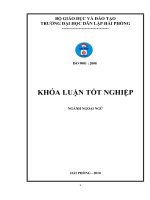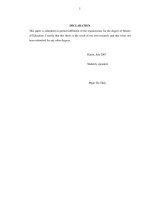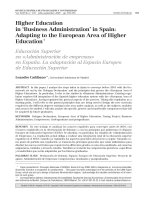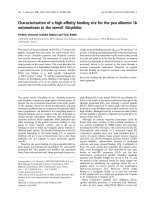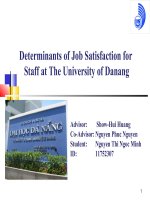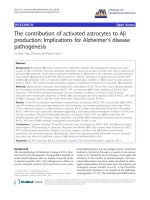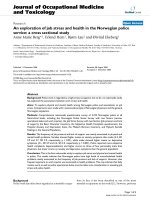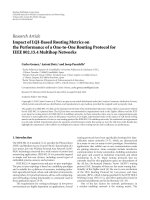Determinants of job seekers to select recruitment agency for new job vacancies master project in business administration
Bạn đang xem bản rút gọn của tài liệu. Xem và tải ngay bản đầy đủ của tài liệu tại đây (807.59 KB, 110 trang )
TRƯỜNG ĐẠI HỌC MỞ TP. HCM
HO CHI MINH CITY OPEN UNIVERSITY
UNIVERSITE LIBRE DE BRUXELLES
SOLVAY BRUSSELS SCHOOL
MBAVB3
PHAN XUÂN BÌNH
DETERMINANTS OF JOB SEEKERS TO SELECT
RECRUITMENT AGENCY FOR NEW JOB VACANCIES
MASTER PROJECT
MASTER IN BUSINESS ADMINISTRATION
(PART-TIME)
Tutor’s Name: Dr. NGUYỄN MINH HÀ
Ho Chi Minh City
(2010)
I
ABSTRACT
The study aims to find out key factors which strongly influence to the selection of
job seekers when approaching recruitment agency for new job. Job seekers’
assessments involve in job vacancy – influences and characteristics of recruiters
and recruitment agency – standard operational procedures practiced by both
recruitment agency and recruiter. The study tries to find out the difference of using
recruitment agency and other sources. Through the assessment of job seekers,
recruiter and recruitment agency will understand which vacancy’s characteristics
they should focus on to communicate and select “right candidate”. The operational
procedures of recruitment services are analyzed to verify its interaction to job
seekers. From the results those working in this services and also recruiter can
consider to leverage the advantages of their companies in attracting more
applicator. Besides, the limitation of recruitment and selection procedure,
interviewer should be corrected to improve the professionalism and attractiveness
of both recruiter and recruitment agency.
Overall, this study tries to figure out the job seeker’s insight when they cooperate
to recruitment agency and recruiter. Well understanding most important
stakeholders, recruitment agency can improve its performance.
Key words:
Recruitment, recruitment agency, recruitment sources, recruitment consultant, job
vacancy, job seekers
II
TABLE OF CONTENTS
CHAPER 1 - INTRODUCTION
1.1 General background ......................................................................................... 1
1.2 Rationale........................................................................................................... 2
1.3 Problem statement ............................................................................................ 3
1.4 Research objectives ......................................................................................... 3
1.5 Scope of study .................................................................................................. 4
1.6 Research method ............................................................................................. 4
1.7 Research structure ........................................................................................... 5
CHAPER 2 – LITERATURE REVIEW
2.1 Introduction and overview ................................................................................ 6
2.2 Definitions ......................................................................................................... 7
2.3 Theory of choices ........................................................................................... 11
2.4 Theory of Customer Behavior ......................................................................... 15
2.4.1 Customer Behavior and Roles of Customer ............................................ 15
2.4.2 Customer Needs and Wants .................................................................. 16
2.4.3 Values sought by User – Job seeker.................................................... 17
2.5 Summary ......................................................................................................... 18
CHAPER 3 - RESEARCH METHODOLOGY
3.1 Proposal research procedure.......................................................................... 19
3.2 Research methodology ................................................................................... 21
III
3.2.1 Qualitative research ......................................................................... 21
3.2.2 Quantitative research....................................................................... 22
3.3 Assessment of measurement of scales ........................................................... 25
3.3.1 General perception of job seekers about sources of recruitment, job
characteristics, and employers influences .................................................. 25
3.3.2 Determinants of factors affect to the selection of recruitment agency
by job seekers ............................................................................................ 28
3.4 Summary ......................................................................................................... 30
CHAPER 4 - RESEARCH RESULTS
4.1 Descriptive statistics on total sample .............................................................. 32
4.1.1 Overall personal information ........................................................... 35
4.1.2 Working Industry .............................................................................. 36
4.1.3 Current position ............................................................................... 36
4.1.4 Sources to find job vacancy ............................................................ 37
4.1.5 Sources to find most recent job vacancy ........................................ 39
4.2 Quantitative study ........................................................................................... 39
4.2.1 Factor analysis................................................................................. 39
4.2.2 Mean analysis .................................................................................. 43
4.3 Exploratory Factor Analysis ............................................................................ 45
4.4 Independent sample test ................................................................................. 55
4.4.1 Working industry ................................................................................ 56
4.4.2 Position .............................................................................................. 58
IV
4.5 Summary ......................................................................................................... 59
CHAPER 5 - CONCLUSION
5.1 Research summary ....................................................................................... 62
5.2 Recommendation........................................................................................... 66
5.3 Limitation & suggestion further researches.................................................... 66
Reference list ..................................................................................................... i
Appendix A ...................................................................................................... iv
Appendix B ...................................................................................................... xi
Appendix C ..................................................................................................... xii
Appendix D ..................................................................................................... xiii
Appendix E ..................................................................................................... xv
Appendix F................................................................................................... xxvii
V
LIST OF TABLES
Table 2.1Customer Behavior Domain ................................................................... 15
Table 3.1 Research procedure .............................................................................. 20
Table 3.2 Variables for factor – Sources of recruitment ....................................... 26
Table 3.3Vacancy characteristics ......................................................................... 26
Table 3.4 Required Information of vacancy .......................................................... 27
Table 3.5 Professionalism of employers and interviewers .................................... 27
Table 3.6 Job vacancy characteristics & attractiveness introduced by RA ............ 28
Table 3.7 Recruitment agency characteristics ...................................................... 29
Table 3.8 Recruitment consultant’ competences................................................... 30
Table 3.9 Convenience of interview by RA ........................................................... 30
Table 4.1 Qualitative statistics............................................................................... 32
Table 4.2 Factor Analysis Results ........................................................................ 47
Table 4.3 Cronbach Alpha’s value of each factor .................................................. 53
Table 4.4 Reliability test results ranking by descending importance ..................... 54
Table 4.5 Statistics Result of Independent-Sample T-test (Service and Supply
Chain – Logistics) for all factors ............................................................................ 56
Table 4.6 Statistics on Independent –Samples T-Test – Factor 4 ......................... 57
Table 4.7 Variable’s mean in Factor 4................................................................... 58
Table 4.8 Statistics Result of Independent-Sample T-test (Officer and Middle
Management position) for all factors .................................................................... 60
VI
LIST OF CHARTS
Chart 4.1 Gender ................................................................................................. 35
Chart 4.2 Working industry ................................................................................... 36
Chart 4.3 Current position of respondents ............................................................ 36
Chart 4.4 Newspaper advert source ..................................................................... 37
Chart 4.5 Post CV on online recruitment website source ...................................... 38
Chart 4.6 Recruitment agency ............................................................................... 38
Chart 4.7 Walks-in ................................................................................................ 39
Chart 4.8 Other sources ........................................................................................ 39
Chart 4.9 Sources for recent job vacancy ............................................................. 40
Chart 4.10 Factors summary ................................................................................. 60
VII
DECLARATION
I declare that the work presented in this thesis has not been previously submitted
for any degree or diploma or at any other higher education institution. I use best of
my knowledge and belief, the thesis contains no material previously public or
written by other person except where due reference is made in the text
SIGNATURE: PHAN XUÂN BÌNH
DATE: JAN 01st 2011
VIII
ACKNOWLEDGEMENTS
Deeply in my heart, I would like to say my big thanks for my parents
who never stop encourage and support me to pursuit my learning. I’m
deeply aware of their sacrifice and promise not to disappoint them.
I would like to acknowledge all my professors and coordinators at
Solvay Brussels School and HoChiMinh City Open University who
provide us valuable knowledge and support with their best wholehearted attitudes.
Of course, I could never have reached this point without the great
assistance of my tutor, PhD Nguyen Minh Ha. His positive feedbacks,
coaching and encouragement help me to find out the best way to
finish this thesis. Thanks so much for your kind assistance.
I also would like to acknowledge the support of my family, friends,
employer
and
colleagues
had
shown
to
me.
Without
their
encouragement and sharing, I will be difficult to do such a work.
For my classmates who have been with me for the whole course,
without their assistance, encouragement and sharing, I may lose my
spirit and face so much difficulties. I extend a huge thanks to all
beloved classmates.
Lastly, I would like to thank all the participants to my research.
1
CHAPTER 1 - INTRODUCTION
1.1 GENERAL BACKGROUND
Vietnam is one of the top highest growing countries in the world for the last decade
and coming years. Together with the high growth is the huge demand of well qualified labor force especially in big economic centers such as Ha Noi and Ho Chi
Minh City.
This trend explains why Vietnam is a very promising market and destination for
recruitment services. Since 1995 many well known consultancies as KPMG, Price
Waterhouse Coppers, Ernst & Young, Grant Thornton had set up its recruitment
services in Vietnam besides the presence of many specialized recruitment agencies
as Manpower, Bo Le, FirstAlliances, L&A, HR capital Vietnam, VIP Database,
HR2B, NetViet. After the recovery of financial crisis in 2009, famous worldwide
recruitment agencies such as Andecco, Robert Walters, Jobstreet, Odgers
Berndtson have eyed Vietnam market. However the increasing growth in term of
quantity of well-experienced labor force is always lower than the demand. This
circumstance explains why there always exists a fierce competition among
recruitment agencies to attract and enrich its candidate’s pool and improve job
seekers’ interest and attention to job openings
Recruitment is one of elements of human resource management as it is the method
to use to acquire the human capital for the organization. That’s why most of foreign
and big local companies use recruitment agencies (or employment agencies) as one
of the key recruitment sources to attract middle to senior employees.
In the view of employer, the time to fill job vacancy and suitability of candidate is one
of key performance indicators to evaluate the quality of recruitment agency services.
2
To meet the demand of clients (recruiters), recruitment agencies (RA) have to be
aware of assessment job seekers to communicate and attract their interests,
attention and intention to job vacancies.
This study tries to indicate the significant factors which affect job seekers’ choice of
recruitment agency as recruitment sources for a new job. The findings are important
for recruitment agencies to navigate, improve its services and enhance quality of its
key manpower – recruitment consultants
1.2 RATIONALE
Recruitment agencies play an intermediate role between employers/ recruiters and
job seekers for a specific job vacancy. It appears that most of employers choose a
recruitment agency despite there is maybe higher expenses of this source than
using other recruitment sources in some extents below:
•
The job vacancy is top confidential and recruiter cannot launch the public
recruitment
•
The vacancy requires very short time to fill
•
The limited staffing resources of recruiting department or
•
The limited candidate pool in some industry or function which may cause very
long time to fill the vacancy or to find out the right candidate
In the view of employers/ recruiters, the pre-hire outcomes means the time vacancy
is filled; the number of qualified shortlisted candidates, candidates’ suitability and fill
rate are important criteria to evaluate the quality of recruitment agency services.
To meet required pre-hire outcome, recruitment agencies (RA) have to understand
their job seekers’ insights and influences to communicate and to attract their
interests, attention and intention to job vacancies.
Consistency to the above reasons, the qualified candidate pool will impact strongly
on the performance and service quality of a recruitment agency (RA). Besides, the
3
rapidly increasing recruitment agencies so far in Vietnam labor market leads to
fierce competition to all RAs to attract and enrich more qualified job seekers and
improve their services. Thus, understanding job seeker’s behavior is fundamental
findings for RAs to build up its strategy, improve service quality and enhance its key
manpower as well as apply professional recruitment procedures.
1.3 PROBLEM STATEMENT
There have been many researches on recruitment and selection and its correlation
to recruitment outcomes. However a study on the determinants of job seekers to
select recruitment agencies as one of recruitment sources has not been conducted
yet, especially in Vietnam. This study tries to indicate what factors influence job
seekers’ decision regarding to new job vacancy through recruitment agency.
By analyzing the significant factors, those working in this service can lever
performance by efficiently approaching their candidates, improving performance and
clients’ satisfaction.
1.4 RESEARCH OBJECTIVES
To give the answers to the above questions, the research objectives are:
1. To identify what factors influence job seekers to select recruitment agency
when they look for new job;
2. To suggest some recommendations for improving performance and quality of
service
4
1.5 SCOPE OF STUDY
In Vietnam, due to the constraint on recruitment budget and also the common
practice of employers, 90% of RAs’ clients are foreign, FDI and local big size
companies1. That’s why this study will only focus on:
• Employees those classified as white and yellow collar worker, working for
nongovernmental organizations, gross salary in range VND 6 –50 million per
month plus working experience at least 3 years in foreign companies, joint
venture or big local private companies
• Survey activities are focused mainly in HoChiMinh city
• The recruitment and selection of foreign, FDI and big local private companies
in HoChi Minh city for officer to senior levels
1.6 RESEARCH METHOD
The main method is quantitative. This research has implemented through 02 steps (1)
qualitative method by interviewing job seekers, recruitment consultants, specialist and
observation and (2) quantitative research
•
Qualitative research defined factors which impact job seekers’ decision when
applying for a new job vacancy; their assessment of recruitment agencies,
recruitment consultants in performing their services. Qualitative research was
implemented by collecting and analyzing feedbacks from job seekers,
recruitment consultants together with discussing during interviews and group
discussion.
•
Quantitative research:
o
Questionnaire conducted by online survey using Google survey tool.
o
Questionnaire sent to list of 1,500 working population which selected from
02 sources by convenience sampling method. (1) 1,200 is the database
1
This number provided by some recruitment consultant specialists working in well- known RA
5
candidates of recruitment agencies (2) other 300 elements which meet
the sample requirement.
o
There are 162 responses. All are valid.
o
Data is processed by SPSS version 13.0
o
Research result is analysed by Exploratory Factor Analysis (EFA),
Measurement of scales tested by Cronbach Apha. Independent- sample
T-tests are also implemented for two groups of service respondents and
supply chain – logistics one to identify any difference in these groups on
assessment the key factors which influence to the selection of recruitment
agency for new job by job seekers.
1.7 RESEARCH STRUCTURE
The research is arranged into 05 parts.
Chapter 1 – Introduction introduces the research background, objectives, scope of
the study and structure.
Chapter 2 – Literature Review provides comprehensive literature on theories of
choice, theory of customer behavior. Some conceptual definitions of recruitment and
selection procedure, recruitment agency, job seeker.
Chapter 3 – Research Methodology presents proposed research procedure;
research methodology includes qualitative and quantitative study. This chapter
defines factors and its variables, measurement of scales.
Chapter 4 – Research Findings – provides an overview of the study including
descriptive statistics, exploratory factor analysis, assessment of measurement of
scales and independent sample tests.
Chapter 5 – Conclusion
6
CHAPTER 2 – LITERATURE REVIEW
Chapter 2 presents some definitions about the job seekers, recruitment, recruitment
sources and recruitment services. The connections between recruitment agency –
employer – job seekers are also explained. Theory of choices, theory of customer
behavior and theory of decision making are fundamental literature from which the
choice of factors and its set of variables relating to this research will be discussed.
2.1 INTRODUCTION AND OVERVIEW:
The most important determinant of organizational effectiveness is the ability to attract,
hire, and develop capable talent. To be able to compete, firms must be able to find
and retain the best available employees. The ability to attract and retain superior
employees can lead to sustained competitive advantage for organizations. Thus,
recruitment and selection is as one of key element of human resources management.
This is difficult due to the shrinking availability of qualified labor. The use of
recruitment agency allows HR departments to target and identify quality candidates
with more efficiency.
Employment agencies is kind of consultancy. Employment
agency provides wide range of employment services as executive search and
selection, employees outsourcing, payroll, etc. Some employment agencies focus
their efforts on executive, managerial, and professional positions. These executive
search firms are split into two groups: (1) contingency firms that charge a fee only
after a candidate has been hired by a client company and (2) retainer firms that
charge a client a set fee whether or not the contracted search is successful. Most of
recruitment agencies in Vietnam apply contingency basis. Only some of the larger
firms work on a retainer basis.
When only mentioning about executive search and selection services, recruitment
agency is normally understood as third party recruiter that finds jobs for people
7
seeking them and finds people to fill particular jobs2 . Executive search professionals
are also involved throughout more of the hiring process, conducting detailed
interviews as well as only presenting candidates to clients where they feel the
candidate in question will fit into the employment culture of the client. Executive
search agencies typically have long-lasting relationships with clients spanning many
years, and in such cases the suitability of candidates is paramount. It is also
important that such agencies operate with a high level of professionalism.
Recruitment agency is a kind of services connecting the right candidate to particularly
job vacancy which required by particular recruiter (employer). So, the outcomes of
recruitment agency means that number of candidates voluntarily accepts the job offer
with minimum time required to fill openings (The length of time it takes to fill
openings). To be successful in performing their task and improving efficiency,
recruitment agency that typically has a wide range of personal contacts within the
area, a detailed specific knowledge of said area, and typically operate at the most
senior level, has to deeply and widely understand determinants on job seekers to
select them as recruitment source when seeking for new job. These research streams
focus on investigating the influences of recruiter’s effects, recruitment agency
characteristics; job vacancy influences to job seekers.
2.2 DEFINITIONS
Job seeker or job applicant or candidate is defined as who is actively looking for a job.
Job seeker may be an unemployed or on-the-job person. In the context of this
research, job seeker means both who is actively and inactively apply for new job
opportunities.
White collar worker3 are officer, clerical, administrative, sales, professional, and
technical employees. White collar jobs are made synonymous to professionals who
2
3
The American Heritage® Dictionary of the English Language, 2000
defined by OECD Glossary of Statistical terms
8
obtained higher degrees and education and more corporate and managerial. White
collar jobs often have a cleaner of ‘better’ workplaces.
Yellow collar worker is mentioned about those works in creative field as
photographer, filmmaker, designer, and artist.
Blue collar workers are not considered as the application population of executive
search and selection services. Blue collar jobs are often non management but actual
physical labor type of jobs
However, there is also different point of view about the classification by Tran Viet
Dzung, Lecturer of Economics, Vietnam National Administration Institute. Mr Dzung
classifies “Blue collar” worker is manual labor; “White collar” worker is expert and.
“Yellow collar” is leaders, directors. Even major stock holders of public companies
also considered as yellow collar worker. Mr Dzung mentions that in financial, banking
industry, yellow collar worker defined as those can influence or create change in the
market. Experts or specialists who have strong network and can make influence on
policy also defines in yellow collar class.
In general, we can conclude that white and yellow collar workers are skilled, well
qualified, well trained and do not involve to daily manual tasks.
Applicant population is a subset of the labor force population that is available for
selection using a particular recruiting approach. For recruitment agency, applicant
population is restricted on those having gross salary from VND Million 6 to 50 per
month and having appropriate competences working for foreign and big local
companies. Applicants are white and yellow collar worker hence they are expected to
communicate in English and familiar to office soft wares; at least 03 years experience
in the same position or industry and other requirements depending on specific job
opening. (Mathis R.L & Jackson. JS, 2005),
Recruitment
9
Barber (1998) defines recruitment as “those practices and activities carried on by the
organization with the primary purpose of identifying and attracting potential
employees”.
Recruitment
has
been
conceptualized
by
Rynes
(1991)
as
encompassing “all organizational practices and decisions that affect either the
number, or types, of individuals who are willing to apply for, or accept, a given
vacancy”. The similar definition of recruitment by Breaugh (1992) “Employee
recruitment involves those organizational activities that (1) influence the number
and/or types of applicants who apply for a position and/or (2) effect whether a job
offer is accepted”
Recruitment sources
Recruitment can focus on the internal labor market (i.e., pursuing staff already
employed by the organization) or the external labor market (i.e., pursuing applicants
from outside the organization). Internal candidates can be recruited through internal
job postings, word-of-mouth, or internship programs. Organizational practices used to
recruit from external labor markets include employment advertising, employee referral
programs, job fairs, college campus recruitment, employment agencies, rehiring
former employees, or networking (Zottoli & Wanous, 2000)
Recruitment agency or Executive Search and Selection Agency
Mahin (1991) noted services in the business-to-business market can be categorized
in two distinct groups: product supported by services and pure services. Consultancy
is belonging to the pure services group, those that are marketed in their own right
without necessarily being associated with a physical product.
Schein, (1987) wrote, process consultation is defined as a set of activities on the part
of the consultant that help the client to perceive, understand, and act upon the
process events that occur in the client's environment
10
Dessler (2002) had clearly defined the employment agencies and classified its type of
services.
There are three types of employment agencies: (1) public agency operated by
government; (2) agencies associated with nonprofit organization; (3) privately owned
agencies.
Private employment agencies are important sources of clerical, white-collar and
managerial personnel. Most are fee paid job in which employers pay the fee. They
charge fees for each vacancy they place.
Executive recruiters or Executive Search and Selection agency are special
employment agencies retained by employers to seek out top management talent for
their clients.
Executive Search and Selection agencies only focus their efforts on executive,
managerial, and professional positions. These firms are split into two groups: (1)
contingency firms that charge a fee only after a candidate has been hired by a client
company and (2) retainer firms that charge a client a set fee whether or not the
contracted search is successful. Most of the larger firms work on a retainer basis.
Search firms are ethically bound not to approach employees.
Contingent-based executive search tend to handle to junior to middle level
management job search.
In the scope of this research, the service of Executive Search & Selection is
analyzed.
Also Dessler (2002) mentioned some reasons to choose RA by employers:
1. Employer doesn’t have its own HR department and is not geared to doing
recruiting and screening
2. Employer has found it difficult in the past to generate a pool of qualified
applicants
3. Employer must fill a particular opening quickly
4. They want to reach currently employed individuals, who might feel more
comfortable dealing with agency than competing companies
11
5. To cut down on the time employer are devoting to recruiting
2.3 THEORY OF CHOICES
N. Mankiw, J. Gans and S.King (2002) had explained some principles influenced
individual making decisions:
Principle 1 - People face trade-offs:
Making decisions requires trading off one goal against another. This principle is
considered in the context of job seekers those currently have a job or receive more
than one job offer. For the former case, they only face trade-offs between their current
job and new job. The latter case requires he/she has to consider all job offers and
finally accept only one. For all situations, job seeker may be stopped their tenure
during probation period and become jobless. It’s obvious that to gain the benefit of
new offer as more attractive remuneration package, higher position, new knowledge
exchange, better working location, etc… Job seeker has to trade off his/ her job
security and other obvious benefits. They will make decision by comparing all aspects
of pro and cons of current job and new offer.
When applying for new job, job seekers always face to the risk of their privacy to be
jeopardized. The more the vacancies they apply, the higher risk of privacy to be
disclosed. The major concern is lack of assurance that private information on an
individual's application form or resume will not be given or sold to a third party or used
for other than hiring purposes (Lin & Stasinskaya, 2002).
In general, the very basic principle ‘People face trade-off’ modifies for the below
factors and variables in this research:
•
Factor ‘ Vacancy characteristics & attractiveness’:
12
o
Job seeker trade off his/her current job security for new “challenging
job” ; “high paid job”; “Preferred working location”; “Convenience of work
place”; “Advancement”; ‘Higher position”
o Trade off current or ‘feasible future’ income (bonus, incentive) for new
job because of similar characteristics mentioned above
o Trade off his confidentially (salary & personal information)
•
Factor ‘Recruitment agency’s characteristics’: in case job seekers agree to
apply specific vacancy through RA, means he can’t coordinate to other RA for
that job. Then he somehow has to consider between his “favorite” RA and
selected RA.
Principle 2 - The opportunity cost:
The opportunity cost is the cost of something what you give up to get that item. When
making decision, decision makers should be aware of the opportunity costs that
accompany each possible action.
When job seekers look for new job openings, the opportunity cost is time, money and
efforts he/ she has to spend to search information, prepare application documents
and attend interviews. Other invisible cost which is difficult to measure is the privacy
to be disclosed during the interview. Most of the recruiters are aware of their
responsibilities and commitment to keep the candidate’s information confidentially.
However, they can’t promise totally follow this rule due to the job change of their
staffs who involve to recruitment process.
This principal is considered to explain these variables:
•
Factor –‘Convenience of interview by RA’: the benefits job seekers estimate to
gain comparing to his time and expenses to join interviews.
13
Principle 3 - Rational people think at the margin
A rational decision maker takes an action if and only if the marginal benefit of the
action exceeds the marginal cost. This principle is the consequence of these above
principles if applying to job seekers’ behavior. As we has explained the opportunity
cost of job seeker when trading off their current job for new job vacancies, job
seekers consider to choose kind of recruitment sources which cost them less and
bring more benefit than other sources. Furthermore, job seekers those handle high
level position are much afraid of revealing privacy. For them, referrals, headhunting or
recruitment agency is more trustworthy sources than walk-ins; to post their resume on
online recruitment website or directly applying.
Salary is the third concerns of employees in Vietnam when change job, according to
XAGE consultancy report on Saigon Time weekly magazine, 40-2010) salary range is
important information to candidate to decide applying or not a job openings. Most of
the company force their employee keep the salary top private and confidential.
Consistency, the job adverts can’t reveal salary range but open negotiable range for
qualified candidate. This policy is good for both employer and employee, however, it
raise a bit confuse because candidates are afraid of they are underpaid. Referring to
this principle, some variables can be explained:
•
Factor – ‘Recruitment sources’:
o Sources has higher probability of success to be set higher priority
o Sources has more useful information for making decision
•
Factor ‘Recruitment agency’s characteristics’
o Among many recruitment agencies, which one can offer he/she better
services or higher probability of success
•
Factor ‘Recruitment consultant’s competences’
14
o Who is the recruitment consultant can provide he/she useful advice;
frequently and timely updating feedbacks; who has deep understand
about the vacancy/ recruiter/ industry
Principle 4 - People respond to incentive
People make decisions by comparing costs and benefits, their behavior may change
when the cost and benefit change. People change their behavior in respond to the
incentive they face.
Job seekers will choose which recruitment sources can offer to them higher benefit
for the same level of job or they can use less resources to gain the offer. They also
consider which sources they can get higher probability of job offer.
To observe the job adverts on printed paper couple years recently in Vietnam for
white and yellow collar worker, most of recruiter accepts or recommend online
application instead of hard application documents. We can conclude that, employers
have to attract applicants not only by their vacancy attractiveness, recruiter influences
but the convenient way to apply also.
•
Factor ‘ Vacancy characteristics & attractiveness’:
o Remuneration packages offered to he/she is consistent or compensated
to what he/she has to do if he accepts new offer. (variable – ‘High paid
job’ & ‘Usefulness of information about vacancy’)
o His offered remuneration package is benchmarking to market pay or not
(variable – ‘High paid job’)
•
Factor –‘Convenience of interview by RA’: the result/ assessment of interview
by RA can be used for further suitable vacancies handled by that RA Æ save
less time, have more chances to be approached by employers. Furthermore,
15
feedback from both recruiter and RA can help candidate recognize his cons
and succeed at other vacancy.
2.4 THEORY OF CUSTOMER BEHAVIOR
2.4 1 Customer Behavior and Roles of Customer
Sheth & Mittal (2004) classified products and services into different sectors
Table 2.1 Customer Behavior Domain
HOUSEHOLD
BUSINESS
PRODUCTS
Consumer Products
Business Products
SERVICES
Consumer Services
Business Services
Recruitment services belong to business sector including management training and
consulting services, employment benefits services, etc.
Regarding to the roles of customer, Sheth & Mittal stated that customer can play
three different roles in the marketplace transaction: User, Buyer and Payer.
The user is the person who actually consumes or uses the products or receives the
benefits of the services. The payer is the person who finances the purchase and the
Buyer is the person who participates in the procurement of the products or services
from the marketplace. Regardless of whether the same person is the user, the payer
or the buyer each role dictates a different set of values that are sought by the
customer.
In recruitment agency, job seeker can be classified as User. Obviously, job seeker is
neither Payer nor Buyer because the services fee is paid by recruiter. Recruiter or
employer plays both roles: Payer and Buyer.
16
About the reasons for role specification, Lack of Time and free from service fee can
be discussed to feature why a certain group of labor forces choose recruitment
agency when seeking for new job.
Lack of time:
Sheth & Mittal (2004) explained that user may delegate the purchasing task (in this
context is looking for new vacancy) to someone else is lack of time. With the support
of recruitment agency, job seeker is updated new suitable vacancy and advised which
vacancy is really match to them if they already set up the connections to recruitment
agency and be ready for new job.
This concept is applied to explain for the influences of information relating to job
vacancy, employer and recruitment process to choice of job seeker in selecting RA.
These items ‘The usefulness and transparency of vacancy’s information’ and ‘Consult
to candidate appropriate information about vacancy and recruitment procedure’ are
select to measure for this factor.
Free from Services Fee
The user is easily to accept the recruitment services because the service is given free
to him.
2.4.2 Customer Needs and Wants
A need is an unsatisfactory condition of the customer that leads him or her to an
action that makes the condition better.
Customer Needs are determined by the traits of the individual and the traits of the
environment. The personal traits determine needs are genetics, biogenic and
psychogenic. Environment traits or market traits are climate, topography and ecology.
